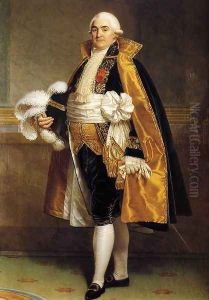Albert Gregorius Paintings
Albert Gregorius, born on March 9, 1774, in Blankenburg (Harz), Germany, was a portrait painter whose work and influence spanned across the late 18th and early 19th centuries. Gregorius's artistic journey commenced in earnest when he studied at the Prussian Academy of Arts in Berlin. His education and early career were significantly shaped by the classical and neoclassical movements that dominated European art at the time, emphasizing clarity, order, and beauty.
After his studies, Gregorius embarked on a career that would see him become a sought-after portraitist, capturing the likenesses of the European elite. In 1801, he moved to Paris, which was then the epicenter of European art, to further his career. There, he was influenced by the works of contemporary French artists, which helped refine his style. Gregorius's portraits were celebrated for their elegance, attention to detail, and the ability to capture the personality and essence of his sitters.
His talents caught the attention of the court in Ghent, and in 1811, Gregorius was appointed as a court painter, a position that significantly boosted his career and reputation. During this period, he painted portraits of several members of the nobility and other prominent figures, securing his status as one of the leading portrait painters of his time.
In 1816, Gregorius moved to Bruges, where he continued his work as a portraitist. He became a central figure in the city's artistic community, contributing to the cultural life of Bruges and mentoring young artists. His influence extended beyond his own works, as he played a significant role in the development of early 19th-century portrait painting in Belgium.
Albert Gregorius's contribution to art was not only in the portraits that he left behind but also in the impact he had on the generations of artists who followed. His ability to adapt his style, while still maintaining a high level of craftsmanship and an acute sensitivity to the character of his sitters, marks him as a significant figure in European art history. Gregorius passed away on January 12, 1853, in Bruges, leaving behind a legacy that continued to influence the world of portrait painting well beyond his time.
